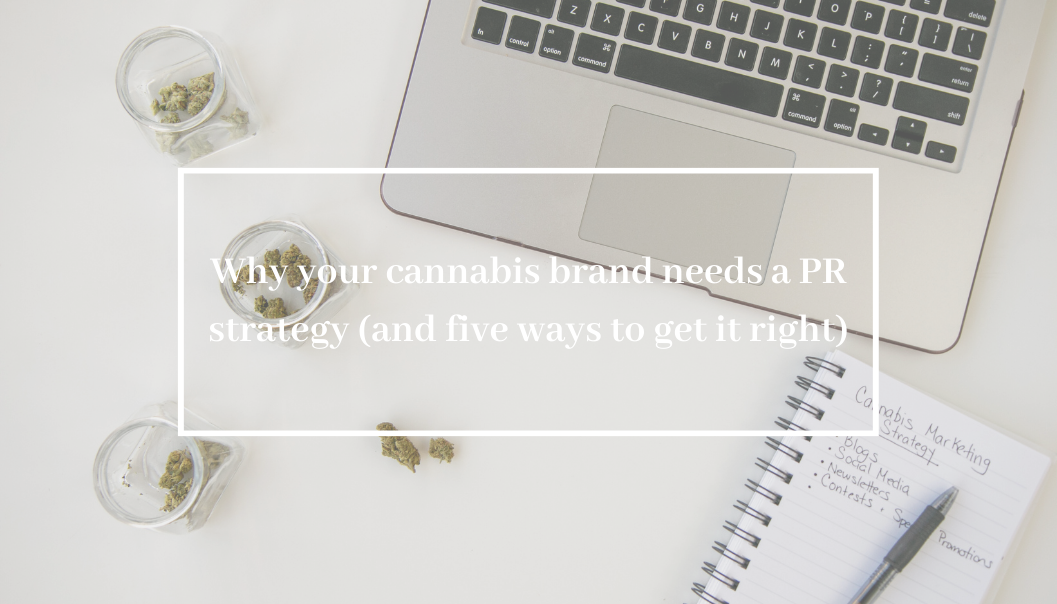
NEWS & PRESS
Why your cannabis brand needs a PR strategy (and five ways to get it right)
In the cannabis space, we speak ad nauseam about the challenges of digital advertising and marketing. But rarely is PR touted as a viable alternative.
You might feel in a content rich and attention poor world, where media returns are diminishing, that it’s scary to spend money on a communications vertical that doesn’t have any guarantees.
However, PR has a lot to offer in this space.
There are lots of people who are curious about integrating cannabis into their lives, but have doubts or mistrust. Maybe they had a bad experience at an unlicensed dispensary or grew up with war on drugs rhetoric they haven’t fully shaken. Pointing to a cannabis brand on a reputable news or lifestyle site, or seeing an endorsement from a well-loved person legitimizes your product and may help assuage their concerns. PR can also help you shorten your sales cycles, or even, at a large scale, contribute to change within policy circles.
We’re robbed of so many of the tools to get our stories out into the world, but we can work with the media to help us tell them through great strategic influencing and relationship building.
How to write a good cannabis PR strategy
Flesh out your key messages and topic areas of interest
Your key messages are the most important messages you want people to hear, understand, and remember. They explain what you do, why you do it, how you’re different, and what value you bring to each of your audiences in bite-sized chunks. It gives you the opportunity to offer clarity about why your brand is different.
Your key messages should be brief and conversational, and align with your mission and business plans and objectives. You could also choose to back them up with a supporting message and proof point.
For example:
[key message] Best Buddie puts people and planet before profit.
[supporting message] Best Buddie uses sustainable farming practices and reinvests money into the local community
[proof point] Best Buddie will reach zero emissions at the end of 2021 through industry-leading energy management and efficiency projects, and has pledged to donate 10% of year-end profits to local environmental justice organizations.
New to brand messaging? Download a free template worksheet.
Similarly, your topic areas of interest should be drawn from your business objectives; highly relevant, and authentic to your brand. Drill down to just two or three to make the most impact.
Topics could be sustainability, artisanship, equality in farming, future technology, activism, or anti-prohibition.
Make sure your key messages are wherever those conversations are happening.
Be driven by data
In traditional PR where awareness was king, column inches and eyeballs were the main metrics of success. If we adopt a revenue marketing model, we can look deeper to a connection to conversion and sales.
Through your Google Analytics platform, you will be able to track how articles or videos drive referral sessions, whether it assisted conversions (where your customer journey led to an eventual sale), and whether it converted that visit.
Outside of Google Analytics and revenue marketing, you could also set targets around email sign-ups and SEO—tracking how you got people into your orbit and brought them into your user journey.
This campaign data can be invaluable. Make sure to not only use it to evaluate the success of one campaign, but to look holistically at the results from all of your activity to help shape your future strategy.
Surgically target your audience
If awareness as a metric is dead, then so too is the ‘spray and pray’ approach to targeting. Lots of brands think that—because the space is still fairly small—any story they have to tell will interest any cannabis-focused outlet.
Instead, we should think about our current or target customer first. How do they consume content? Are they more likely to listen to a podcast on the train, watch local news, or be enraptured by in-depth YouTube videos?
Once you know where your audience spends time, you can study the output of those media to tailor your story for them, or pitch new content. The goal is to make genuine, relevant connections with people who work on the media your audience is watching and delivering valuable content, instead of sending the same press release to 500+ email addresses and crossing your fingers. It will take longer to get off the ground, but the payoff will be worth it.
Understand the macro and micro topics affecting your business
Even when we hone in on the topics that are relevant for us to talk about publicly, it doesn’t mean that we shouldn’t be prepared that other issues will affect how our brands and stories are perceived. Some of them will be macro, like legalization, farming, medical research, and others will be micro, like the activity of our competitors or behavior of our employees. Your business might already have a plan for what happens when federal prohibition ends or a crisis plan for what would happen if you have a disgruntled employee or data breach. If so, be guided by those plans in your consideration of how these issues could affect your stories.
Craft your pitches
Content pitches revolve around the question, “why does it make sense for this outlet to accept my pitch?” It should demonstrate that you understand and share their audience, that you’re the subject matter expert, and that your piece would align with the tone and opinions they express.
Your pitches should include:
- Some noteworthy points from your content
- A spokesperson they can have access to
- The angle of the piece, or outline
- An explanation of your company featuring your key messages
Bear in mind, you might also have to teach the reporter, blogger, influencer, or YouTuber about cannabis; they might not have the requisite knowledge to do justice to your piece, or say something salesy that gets the content deplatformed for advertising.

